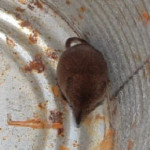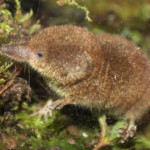Years ago I commanded an Army recruiting company in upstate New York. The job required a lot of “windshield time” as I drove from one recruiting station to another. I normally packed a lunch for these little journeys and always selected a convenient setting of natural beauty for my afternoon lunch break. One day I found a beautiful little spot just off the road near a flowing brook. I pulled over, rolled down the window, and settled into a tasty ham sandwich as I watched the gentle waters flowing by. I was hungrily into my third bite when I saw something stopped me in mid chew and made me wonder if I was hallucinating – a mouse swimming underwater.
Common Shrew. Note the long, pointed snout, tiny eyes and ears. Mice have large eyes and distinct ears.
I had never seen such a thing! I carefully opened the car door and got as close as I could to the strange creature. Sure enough it was a small, mouse like mammal swimming underwater, scooting about and frantically probing between rocks and other submerged objects. What an incredible sight! I observed the little guy for about five minutes until it suddenly and swiftly disappeared. A book I’d read years before by the great animal behaviorist Dr. Conrad Lorenz popped into my mind and I realized I’d seen a water shrew. No matter how many times I stopped by that stream afterward I never saw the creature again, but it remains as one of the most memorable sights I’ve ever had the pleasure to witness.
Shrews are the smallest mammal in North America and one of the two smallest mammals in the world. (With an adult weight of just 2 grams the Etruscan shrew, Suncus etruscus, is the smallest). At 2 – 3 inches the Pigmy Shrew holds the record for smallest North American mammal. At 5-6 inches the Water Shrew I had observed is a giant by comparison. In between those extremes we have a surprising number of these little guys:
Shrews (family Soricidae)
Marsh Shrew Sorex palustris: 5 – 7 inches; our biggest species; Pacific Northwest coastal regions from Washington to northern California
Masked or Common Shrew Sorex cinereus : 5-6 inches; throughout North America largest range of any shrew (also called a Cinereus Shrew)
Merriam’s Shrew Sorex merriami: 3-4 inches; found throughout arid parts of western US
Montane Shrew Sorex monticolus : 4-5 inches; western North America from Alaska to Mexico (also called a Dusky Shrew)
Water Shrew Sorex palustris : 5-6 inches; an aquatic shrew found in watery habitats in northern parts of North America on the east and west coasts; absolutely fascinating animal to observe!
Preble’s Shrew Sorex preblei : a very small (about 3 inches), relatively unknown shrew of the arid regions of the Northwest.
Trowbridge Shrew Sorex trowbridgii: 4-5 inches; inhabits the coastal regions of the western US
Wandering or Vagrant Shrew Sorex vagrans: Approximately 4 inches; moist regions from British Columbia and into northern California and Nevada
Your ads will be inserted here by
Easy Plugin for AdSense.
Please go to the plugin admin page to
Paste your ad code OR
Suppress this ad slot.
Pigmy Shrew Microsorex hoyi : 2-3 inches; prefers the northern regions of Canada and into Alaska
As you can see from the list above we have a nice variety of these animals in the US, some with ranges extending into Canada and Alaska. That’s quite a feat for a warm blooded animal that can fit in the palm of your hand. And when you consider the fast and furious life style that shrews must maintain to stay alive it is all the more amazing. This is an animal that can literally starve to death in just hours. Now that’s a fast metabolism. Their heart rate when excited can reach as high as 1200 beats per minute. As a result shrews can easily die of shock or fright from loud noises as well. Despite the obvious drawback of this metabolic maintenance have developed a number of unique abilities:
Excellent hearing and sense of smell makes up for poor eyesight
Some have poisonous salivary glands; primarily for immobilizing small prey but reported to be rather painful for humans
A fringe of hair on the feet of some shrews enhances their swimming ability and allows them to even skitter across the water surface
Not all are strictly ground dwellers either; some can climb trees
Perhaps the most interesting, and relatively recent discovery about shrews, is the ability for echolocation. Theirs is not nearly as sophisticated as bats, however. Shrews use this ability as a method to recognize their immediate habitat; a useful trick for a small animal normally living in dark, dark places. According to Thomas E. Tomasis (credited below) only two genera of North American shrews have this ability (Sorex and Alaripa). They are joined in this special talent by just one other terrestrial mammal, the Madagascan tenrec, also part of the insectivore family.
Where to find shrews? Perhaps the most common way to find a shrew is by turning over logs, boards, etc. or coming through the leaf litter they prefer. By and large shrews are not burrowers so they are more often found than moles. “Have a Heart” traps are available but there is a cheaper, homemade alternative. Dig a small hole, insert a coffee can or something similar, and place a bit of meat such as cat food in the can. Be sure to check the trap frequently – remember, these little guys need a lot of fuel to keep going. And unless you are prepared to constantly refill that fast and furious shrew metabolism observe the little guy for a while and let it go. Shrews have a very short life and unless you know what you are doing that life will be a lot shorter.
References:
Walkers Mammals of the World Sixth Edition, Volume 1999
“Echolocation by the Short Tailed Shrew” by Thomas E. Tomasis; Journal of Mammalogy Vol 60, No 4 (Nov 1999)
“Of Moles and Men – the Battle for the Turf” by Dr. Patrick Thompson
Internet Center for Wildlife Damage Management – Cornell University: http://icwdm.org/handbook/mammals/shrews.asp
National Geographic: http://www.nationalgeographic.com/
HOOAH
Jack



Leave a Reply
You must be logged in to post a comment.